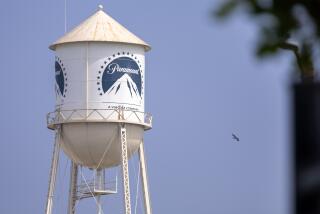Kirk Kerkorian: Friend or Foe? : His Presence in the MGM Deal Receives Mixed Reviews
- Share via
What does Kirk Kerkorian want?
Former associates of the Las Vegas billionaire hailed his reemergence as a likely owner of MGM studios as proof that he always intended to keep it running as a functioning studio--despite his record of trading its name and its assets in a series of complex deals spanning more than 20 years.
“I would assume he’s trying to make the studio viable,” said Frank Yablans, a former co-chairman of MGM with Kerkorian. “He always wanted it to be a success.”
Added Frank Rothman, who served under Kerkorian as MGM chief from 1982 to 1986: “He has an attachment to MGM and a definite interest in seeing that it stays around.”
Both Yablans and Rothman noted that Kerkorian’s role in what would be his third term as an MGM owner would be as a financial backer of MGM Chairman Frank Mancuso in a management-led buyout. “He’s definitely keeping the management in place,” Rothman said.
That would make sense, given that Mancuso has reinvigorated the ailing studio with such box-office successes as “GoldenEye,” “Get Shorty” and “The Birdcage.”
Still, the studio is tiny compared with major competitors, having lost its studio lot and a major part of its library and lacking traditional cash cows such as licensing fee sources--largely because Kerkorian sold them off in his previous terms.
Kerkorian’s critics have said he views businesses largely as commodities to be broken apart and sold at will. Others note that he ran MGM as an operating studio for 20 years and has made his fortune more by developing businesses such as airlines and resort hotels rather than by trading for short-term gain.
Last year Kerkorian sparked a run-up in Chrysler Corp. stock by threatening a takeover bid with former Chrysler Chairman Lee Iacocca. The threat evaporated when it became clear that Kerkorian did not have the financing for the multibillion-dollar transaction.
Asked what MGM might have to attract the trader in Kerkorian, Yablans chuckled and said: “There’s not a whole lot to work with. He sure isn’t doing this as an asset play.”
Rothman argued that Kerkorian might try to find synergies between his Las Vegas hotel, the MGM Grand, and the studio--signing stars of MGM movies to promote Vegas events, for instance.
*
Kerkorian’s long affair with MGM started in 1969, when he bought 40% of the studio for $82 million in a hostile takeover. In 1981, he bought United Artists for $380 million, then combined the two studios and five years later sold the package to Ted Turner for $1.5 billion.
Five months later, he bailed Turner out of financial straits by repurchasing all of MGM/UA for $80 million, except the MGM film library. (Turner parlayed the library, which includes “Gone With the Wind,” “Singin’ in the Rain,” “The Wizard of Oz” and other classics, into the feedstock of his cable movie channels.)
Meanwhile, Kerkorian sold the studio again in 1990, this time to Giancarlo Parretti’s Pathe Communications Corp. for $1.3 billion.
The Turner and Parretti transactions both landed Kerkorian in court. After the Turner deal, MGM shareholders contended that he had grossly undervalued the UA film library by $100 million when he repurchased it while raising his MGM stake from 51% to 80%. The deal, argued the shareholders, had the effect of enriching Kerkorian by $50 million at their expense.
Kerkorian settled that suit for $35 million the day before he was scheduled to take the stand.
The Parretti sale proved even more convoluted, resulting in a $1-billion lawsuit filed by Credit Lyonnais, the French bank that financed Parretti’s purchase and was left holding worthless debts when MGM-Pathe collapsed in 1991. Credit Lyonnais claimed Kerkorian, eager to salvage the sale after Parretti’s financing fell through, sold off licensing rights to the UA film library for $625 million, then transferred that sum to Parretti.
In return for the money, MGM got Pathe assets it valued at $625 million but which were worth only a fraction of that. In the end, the bank alleged, Parretti paid Kerkorian more than $1.3 billion to buy an MGM/UA mortally crippled by the licensing sale.
Kerkorian settled the suit in October for a reported $125 million, around the time that he was preparing the abortive run at Chrysler. Credit Lyonnais, for its part, had seized MGM after Parretti defaulted on its loans.
Taken together, the sales led to Kerkorian’s image as a ruthless asset stripper interested only in the trading value of a Hollywood institution. His former executives, however, argue that the latest deal demonstrates the image was wrong.
*
“There’s been a serious misperception of what he had in mind with MGM,” said Rothman from his L.A. office at the law firm of Skadden, Arps, Slate, Meagher & Flom. “His attitude was always to keep the studio operating as a studio.”
After Kerkorian sold off most of its assets, he retained the rights to use the MGM name and its signature “Leo the Lion” logo on his hotel and his luxury airline, the now-defunct MGM Grand Air.
Rothman also argued that Kerkorian’s machinations with Turner were aimed at salvaging UA as a going concern after Turner’s financial problems surfaced.
“He set it up to keep United Artists alive,” Rothman said.
As for the Parretti deal, Rothman said, “that turned out to be not the best thing in the world, for reasons not Mr. Kerkorian’s fault.”
MAIN STORY: A1
(BEGIN TEXT OF INFOBOX / INFOGRAPHIC)
Third Time a Charm?
Although billionaire Kirk Kerkorian hasn’t explained his reasons for seeking a stake in MGM, longtime associates say his intention is to make the studio great again. A look at Kerkorian and MGM:
* This would be Kerkorian’s third term as an owner of the studio; he first bought a stake in 1969, sold and bought it back in 1986 and then sold it again in 1990.
* Kerkorian is backing a successful management team responsible for MGM’s recent turnaround with box office hits such as “The Birdcage,” “GoldenEye” and “Get Shorty.” But due to the distraction of the sale, MGM has not had a movie in production since last year; however, it now expects to go full steam ahead.
* Some analysts say Kerkorian gives MGM strong financial backing.
* Kerkorian’s previous stints at MGM were marred by accusations that he was interested only in stripping it of its most valuable assets for personal gain. Associates say his intention was always to make MGM a successful studio.
The Pride of MGM
MGM, no longer the dominant force it once was in the studio world, has undergone a revival under the management team led by Frank Mancuso. It’s major assets:
* The Name: The MGM name, with its rich history, is one of the most recognizable in the entertainment world.
* Film Production and Distribution: It is one of a handful of companies that finance, produce and distribute a full slate of movies domestically. Recent hits include “Get Shorty” and “The Birdcage.” It also is a partner in United International Pictures, which distributes the films of MGM, Universal and Paramount.
* Library: The MGM library was sold to Ted Turner in the 1980s, but the studio still owns Hollywood’s fifth-largest film library, with a total of 1,559 titles, including those of United Artists and post-1986 MGM. (There are 17 James Bond movies, five “Rockys” and eight “Pink Panthers,” as well as “Annie Hall,” “Raging Bull” and others.) The library also has several thousand hours of television programming.
* Television: MGM has two series in first-run syndication (“The Outer Limits” and “LAPD”), commitments from Showtime Networks and several equity investments in foreign television platforms.
* Video Distribution: Videos are distributed through Warner Home.
More to Read
The biggest entertainment stories
Get our big stories about Hollywood, film, television, music, arts, culture and more right in your inbox as soon as they publish.
You may occasionally receive promotional content from the Los Angeles Times.










